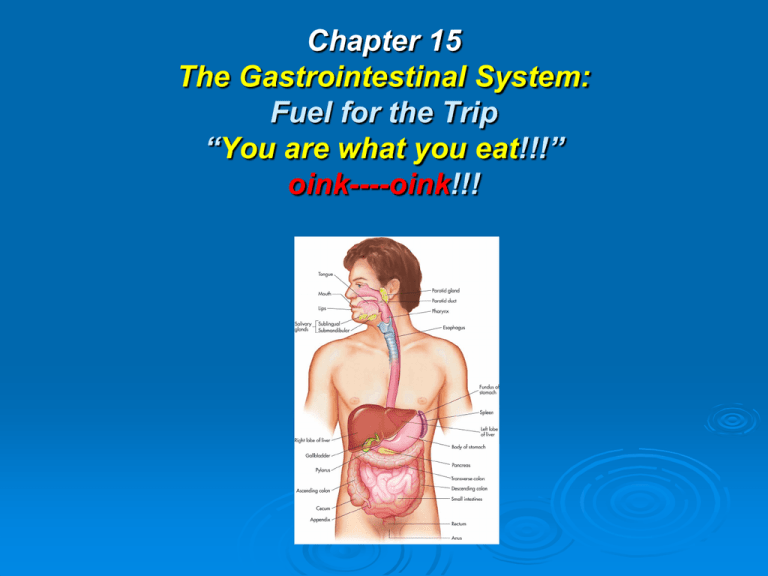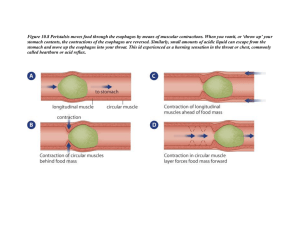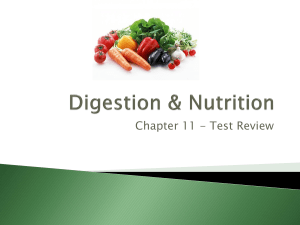Chapter 15 The Gastrointestinal System: You are what you eat
advertisement

Chapter 15 The Gastrointestinal System: Fuel for the Trip “You are what you eat!!!” oink----oink!!! Introduction Gastrointestinal System Functions: Ingest raw materials Physically & chemically digest raw material to usable elements. Absorb elements Eliminate what is NOT useable System Functions Ingestion: food enters mouth Mastication: chewing Digestion: chemical act of breaking down food into small molecules. Secretion: acids, buffers, enzymes, & H2O aid in breakdown of food. Absorption: molecules pass through lining of digestive tract. Excretion or defecation: elimination of waste products. The Digestive System Buccal (oral) Cavity Lips: act as door to cavity Hard & Soft Palate: form roof of mouth Tongue: acts as floor Cheeks: form walls Tongue Muscle: provides taste stimuli to brain, determines temperature, manipulates food, & aids in swallowing. Saliva: added to moisten & soften food, while teeth crush food. Bolus: ball-like mass, pushed by tongue so it may be swallowed, passed to pharynx. Lingual Frenulum: membrane under tongue, keeps you from swallowing tongue & aids in speaking. Buccal & Oral Pharynx Salivary Glands Sublingual: found under tongue Submandibular: located along both sides of inner surface of mandible, or lower jaw. Controlled by: autonomic nervous system Parotid: slightly inferior & anterior to each ear. Swell with “viral Parotitis..” Salivary Glands con’t Produces: 1–1.5 liters of saliva QD Keep mouth moist: but idea or presence of food increase production significantly. Contains: 99.4% water, & contains antibodies, buffers, ions, waste products, & enzymes. Salivary Glands con’t Enzymes: act as organic catalysts to speed up chemical reactions. Salivary Amylase: speeds chemical activity of breaking down carbohydrates. Saliva cleans oral surfaces, reducing amount of bacteria that grows in mouth. Teeth Deciduous: first set of teeth as a baby First tooth: appears @ 6 months of age; lower central incisors appear first, all 20 teeth in place by age 2½. Between 6 and 12 years these teeth fall out, are replaced by 32 permanent teeth. Wisdom teeth: appear by age 21 Teeth Con’t Incisors: at front of mouth, blade shaped, used to cut food. Canine: for holding, tearing, or slashing food; known as eyeteeth or cuspids, located next to incisors. Bicuspids: or premolars: transitional teeth Molars: have flattened tops; both bicuspids & molars are responsible for crushing & grinding food. Teeth Con’t Parts of Tooth: Crown: covered by hard enamel. Neck: transitional section that leads to root. Root: nestled in bony socket, held in place by fibers of periodontal ligament. Dentin: made of mineralized bone-like substance. Teeth Con’t Connective tissue: pulp, located in pulp cavity Pulp cavity: contains blood vessels & nerves providing nutrients & sensation; nerves & blood vessels get to pulp cavity via root canal. Cementum: (soft version of bone) covers dentin of root, aiding in securing periodontal ligament. Teeth Con’t Gingiva: gums, help hold teeth in place Epitheal cells form tight seal around tooth to prevent bacteria from coming into contact with tooth’s cementum. Pathology Connection: Oral Disorders Dental Caries (cavities) Form when microorganisms attack tooth enamel Related to dental plaque: sticks to teeth forming sticky substance. Forms great hideout for bacteria Bacteria creates acids that attack surface of teeth. Risk Factors for Plaque Formation High carbohydrate diet Poor dental hygiene Lack of regular visits to dentist Risk Factors for Plaque Formation con’t RX: Clear out & fill caries Rx infection Prevention: Proper dental care Fluoride in H2O & tooth paste Evaluate for heart disease & buccal ca Pathology Connection: Periodontal Disease Plaque & bacteria affects gums & supportive structures of teeth. Can result in gingivitis, bleeding & tooth loss Pathology Connection: Oral & Lip Cancer Cause: Excessive sun exposure Tobacco ETOH Oral & Lip Cancer con’t Leukoplakia: white patch of tissue in mouth associated with use of chewing tobacco Pathology Connection: Stomatitis Inflammation of oral mucosa poor fitting dentures Apthous stomatitis (“canker sores”) Cheilitis: cracking & inflammation of lips & corners of mouth; often related to infection, allergy, or nutritional deficiency. Pharynx (3 Parts) Nasopharynx: primarily part of respiratory system, blocked by soft palate. Oropharynx & laryngopharynx: act as passageway for food, water, & air; epiglottis covers trachea to prevent food from entering lungs, forcing food into opening for esophagus. Esophagus 10 inches long, is connected to stomach from pharynx, through thoracic cavity, through diaphragm, connecting to stomach in peritoneal cavity. normally collapsed tube until “bolus” of food swallowed. Peristalsis: pushes food down esophagus Esophagus con’t lined with stratified squamous epithelium that secrete mucus to make walls slippery; cells make lining. resistant to abrasion, temperature extremes, & irritation. Pharyngoesophageal sphincter: relaxes to open esophagus so food can enter. Esophagus con’t Lower Esophageal Sphincter: opening door to stomach & closing to prevent acidic gastric juices from splashing into esophagus causing heartburn. process of swallowing: food 9 seconds; fluid take only seconds to reach stomach. Walls of the Alimentary Canal Stomach Located: ULQ under diaphragm, posterior to Liver. 10 inches long with diameter dependent on how much just eaten. 4 liters when filled Rugae: folds, help stomach expand and contract. 4 Function of Stomach Holding area for received food Chemical digestion: gastric acids & enzymes mix with food. Regulates rate of Chyme movement into small intestines. Absorbs small amounts of H2O & ETOH How Fast Stomach Empties 4 hours to empty following meal Liquids & carbohydrates pass quickly Proteins take longer Fats take longest 4-6 hours 4 Regions of Stomach Cardiac Region: surrounding lower esophageal sphincter. Fundus: laterally & slightly superior to cardiac region. Temporarily holds food as it enters stomach. Body: Mid-portion Pylorus: 1. terminal end of stomach 2. most of work performed 3. where food passes through pyloric sphincter into small intestine. Chemical Digestion Gastric Juice: 1500 mls produced QD hydrochloric acid (HCl) pepsinogen mucus Pepsinogen, HCL & Pepsin Enzymes chief digestive enzyme secreted by chief cells HCL secreted by parietal cells combining to produce pepsin. Pepsin breaks down protein HCl breaks down connective tissue Stomach & Enzymes con’t HCL: pH of 1.5–2.0, effective at killing pathogens. Mucous cells: generate thick layer of mucus shielding stomach from effects of stomach acids. Stomach secretes intrinsic factor, allowing vitamin B12 to be absorbed. Enzyme activity controlled by parasympathetic nervous system (vagus nerve) Vagus increases motility & secretory rates of gastric glands. Gastric Glands & Their Functions 3 Phases of Gastric Juice Production I. Cephalic Phase: sensory stimulation (sight or smell of food) stimulates parasympathetic nerves via medulla oblongata Gastrin released stimulating gastric gland activity in stomach 3 Phases of Gastric Juice Production con’t II. Gastric Phase: 2/3 of gastric juices secreted as food enters stomach & distends walls. signaling stomach to secrete more gastric fluid 3 Phases of Gastric Juice Production con’t III. Intestinal Phase: food enters duodenum, distending & sensing acidity. intestinal hormones released slowing gastric gland secretions lasts until bolus leaves duodenum 3 Phases of Gastric Juice Production con’t Rate of Movement of Chyme If too slow: rate of nutrient digestion & absorption decreased may allow acidity of chyme to cause erosions of stomach lining (ulcers). If too quick: food particles may not be sufficiently mixed with gastric juices. insufficient digestion; chyme not given time to neutralize can cause erosion of intestinal lining (ulcers). Pathology Connection: Stomach Acid Disorders Gastroesophageal Reflux Disease (GERD) Condition where acidic stomach contents “squirt” back into esophagus Since esophagus does not have protective mucus, can cause inflammation and ulceration of esophageal tissue Scar tissue can eventually form, causing narrowing of esophagus If left untreated, constant inflammation can lead to esophageal cancer GERD cont. s/s epigastric pain and burning, can be worse when lying down d/x symptoms, upper GI R/x • Antacids: treat burning sensation by decreasing acid • Acid reducing meds • Lifestyle changes: may help prevent GERD Limiting fats, alcohol, caffeine and chocolate in diet Avoiding smoking Avoiding lying down in 4 hours after eating Sleeping with head of bed elevated If obese, weight loss Peptic Ulcers Etiology: Breakdown of mucosal membrane in esophagus, stomach, or small intestine; develop most commonly in duodenum Factors that increase risk: • • • • Helicobacter pylori (H. pylori) infection in stomach: Smoking Heavy/chronic alcohol consumption Use of NSAID medications (including aspirin and others) • Caffeine consumption Peptic Ulcer cont. • Use of corticosteroid medications • Stress Small Intestine major organ of digestion, is where most of food digested average length of 6– 20 feet and diameter ranging from 2.5-4 cm Walls secrete digestive enzymes and hormones to stimulate pancreas Small Intestine cont. 80% of absorption of usable nutrients occurs in sm. Intestine Remaining 20% absorbed in stomach Any residue not utilized in small intestine sent to large intestine for removal from body Sections of sm. intestine Three regions Duodenum: approximately 25 cm long (10 inches) Jejunum: middle section, approximately 2.5 m long Ileum: terminal end, 2 meters long, attaches to large intestine at ileocecal valve Sm. Intestine cont. Pyloric valve allows small portions of chyme to enter duodenum Pancreas and gallbladder add secretions: bile from gallbladder, pancreatic juice with enzymes from pancreas Bile emulsifies fat, making fat disperse in water Pancreatic juice contains sodium bicarbonate which neutralizes acidic chyme Sm. Intestine Cont. Wall has circular folds called plicae circulares and finger-like protrusions into lumen called villi Villi also have microscopic extensions known as microvilli Purpose: to provide increase in surface area of small intestine (almost to size of tennis court) increasing efficiency of absorption of nutrients Villi Large Intestine Beginning at junction of small intestine, ileocecal orifice, and extending to anus Borders small intestine No villi in large intestine so little nutrient absorption occurs here Functions of Large Intestine Water absorption Absorption of vitamins produced by normal bacteria in large intestine Packaging/compacting waste products for elimination from body Lg. Intestine cont. 5 feet long and 2.5 inches in diameter 3 main regions: cecum, colon, and rectum cecum, receives any undigested food and water from ileum Large Intestine *Four sections of colon: ascending, transverse, descending, and sigmoid *Ascending colon travels up right side *Transverse colon travels across abdomen just below liver and stomach *Descending colon travels to left side Lg. Intestine cont. Sigmoid colon extends to rectum Rectum opens to anal canal that leads to anus Anal sphincter opens and closes to allow passage of solid waste (feces) Role of Intestinal Bacteria Help break down indigestible materials Produce B complex vitamins and most of vitamin K needed for proper blood clotting Pathology: Lg. Intestine Hemorrhoids Etiology: varicose veins in rectum S/S: pain, itching/burning sensation, bleeding Dx: proctoscopy, stool sample examination Tx: dietary changes (more fiber/water), stool softeners, medication to relieve discomfort Colorectal Cancer Risk factors include: • Genetic predisposition • Diet rich in animal fat • Diet lacking appropriate amounts of fiber and calcium • Tobacco usage and excessive alcohol consumption • Higher than normal levels of “bad” cholesterol in serum • Sedentary lifestyle Colorectal Cancer cont. S/S: Dx: Tx: rectal bleeding, possible abd. pain colonoscopy surgical removal of tumor, chemo, radiation possible. Diverticulitis Etiology: infection and inflammation of diverticulum (sac in intestinal tract) S/S: bleeding, abd. pain, fever, hyperactive bowel sounds Dx: patient hx and exam, blood work, colonoscopy, endoscopy Tx: high fiber diets, stool softeners, antibiotics, surgical intervention Diverticulitis Accessory Organs -Liver -Gall Bladder -Pancreas Liver Weighs 1.5 kg, is largest glandular organ in body Divided into large right lobe and smaller left lobe; right lobe has two smaller inferior lobe Receives about 1½ quarts of blood every minute from hepatic portal vein and hepatic artery Functions of the Liver Detoxifies body of harmful substances such as certain drugs and alcohols Creates body heat Destroys old blood cells Eliminates the pigment bilirubin in bile which gives feces its distinctive color Forms blood plasma proteins, such as albumin and globulin Functions of the Liver cont. Produces clotting factors fibrinogen and prothrombin Creates anticoagulant heparin Manufactures bile Stores and modifies fats for more efficient usage by body’s cells Synthesizes urea, a by-product of protein metabolism Functions of the Liver cont. Stores glucose, as glycogen; when blood sugar level falls below normal, liver reconverts glycogen to glucose and releases it into the blood Stores ions, vitamins A, B12, D, E, and K Makes cholesterol Gall Bladder Sac-shaped organ, 3–4 inches long, located under liver’s right lobe Stores bile and absorbs much of its water content, making it 6–10 times more concentrated; if over-concentrated, bile salts may solidify, forming gall stones Fatty foods in duodenum cause release of CCK which causes bile to release into the duodenum via common bile duct Pathology Connection: Cholelithiasis and Cholecystitis Etiology: inflammation of gallbladder; presence of stones or calculi in gallbladder or common bile duct Incidence increases with age, common in men, women following multiple pregnancies, obese patients, diabetics, and patients who have had rapid weight loss Cholelithiasis cont. S/S: • Asymptomatic/mild discomfort to extreme pain often preceded with ingestion of fatty or greasy foods • pain usually steady lasting from 15–30 minutes or up to several hours with spontaneous resolution • nausea/vomiting, bloating, flatulence, abdominal tenderness • Possible low grade fever Cholelithiasis cont. Dx: exam/pt hx, ultrasound, blood work with rise in leukocyte count during acute cholecystitis (although other values usually within normal range) Tx: changes in diet, observation, surgical removal if deemed severe enough Cirrhosis Etiology: enlargement of liver (hepatomegaly) with normal tissue being replaced with fibrous tissue S/S: decrease in its function, nausea/vomiting, weakness, jaundice, swollen ankles (edema), loss of weight, loss of body hair, massive hematemesis, coma, death Dx: patient exam and history, blood results Tx: cessation of causative agent Hepatitis Etiology: inflammatory condition, most common chronic liver disease; five types: (A,B,C,D,E) each with differing routes of infection, severity and complications have been identified S/S: hepatic cell destruction, hepatomegaly, fever, weakness, nausea, anorexia, arthralgia, jaundice, skin eruptions, dark urine Dx: patient history, physical exam, blood testing/screening Tx: antiviral drugs Jaundice Pancreas Endocrine gland that has role in digestion 6–9 inches long, located posterior to stomach, and extends laterally from duodenum to spleen Secretes buffers and digestive enzymes through pancreatic duct to duodenum Buffers neutralize acidity of chyme to protect the intestinal walls Pancreatic Enzymes Hormones from the duodenum activate enzyme secretion Enzymes: Carbohydrase: works on sugars and starches Lipase: works on lipids Proteinase: breaks down proteins Nuclease: breaks down nucleic acids Pancreas Pancreatitis Etiology: Inflammation of pancreas Possible causes Blockage of bile duct (causing pancreatic enzymes to back up into pancreas) Excessive alcohol consumption Irritation Pancreatitis cont. S/S: severe abd. Pain, N/V Dx: physical exam and hx, enzyme levels elevated Tx: depends on severity of symptoms NPO Total Parental Nutrition Pain management Pathology Connection: Crohn’s Disease Etiology: form of chronic inflammatory bowel disease affecting ileum and/or colon S/S: pain, cramps, diarrhea, bloating, weight loss Dx: physical exam and history, radiologic studies Tx: anti-inflammatory meds such as prednisone, surgical intervention if severe Gastritis Etiology: acute or chronic inflammation of stomach; due to infection, spicy foods, excess acid production, stress, alcohol, aspirin consumption, heavy smoking S/S: pain, tenderness, nausea, and vomiting Dx: patient history, imaging studies, endoscopy, gastric biopsy Tx: antacids, antibiotics (if bacterial infection) Intussusception Etiology: result of intestine slipping or telescoping into another section of intestine just below it often in ileocecal region; common in children S/S: pain Dx: radiographic studies Tx: surgery Peritonitis Etiology: infectious and/or inflammatory process of peritoneum; may be due to leakage of contents from gallbladder, appendix, duodenal ulcer, penetrating injuries or result of cancerous tumor S/S: pain, fever, malaise, shock, abscesses Dx: patient history, physical examination, blood work Tx: correction of cause, surgical intervention, antibiotics







